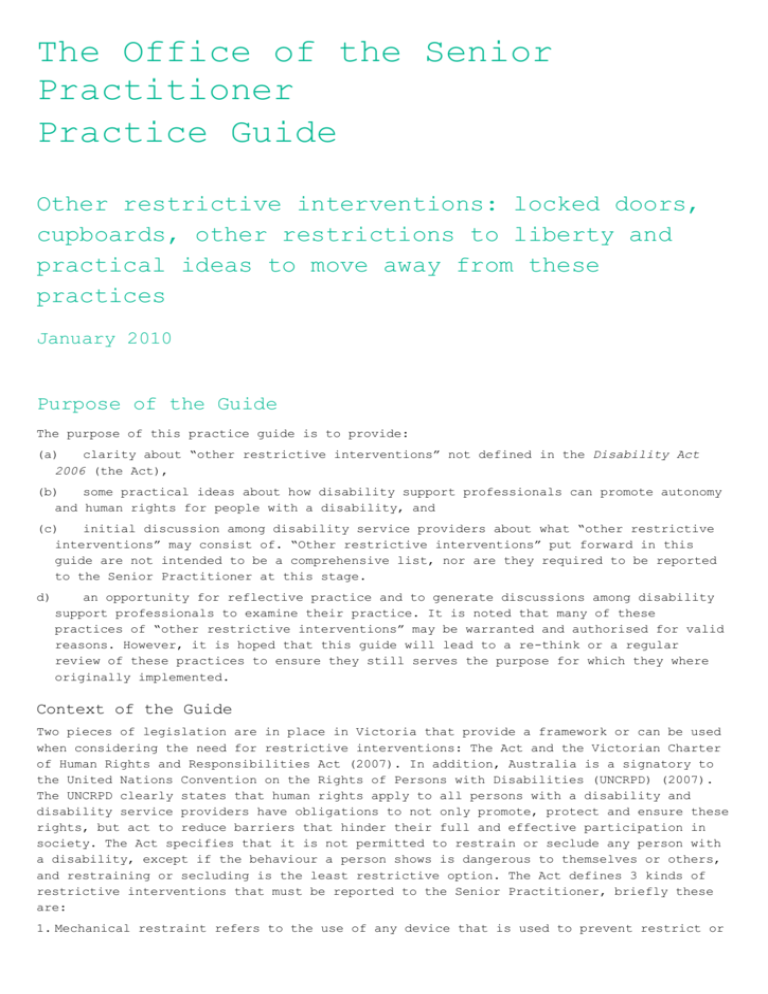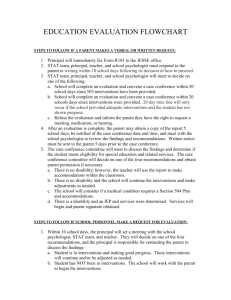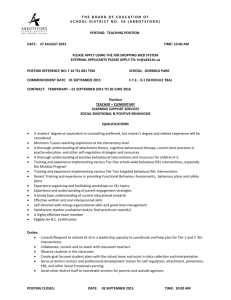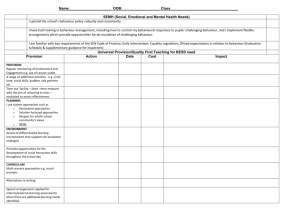Other restrictive interventions practice guide
advertisement

The Office of the Senior Practitioner Practice Guide Other restrictive interventions: locked doors, cupboards, other restrictions to liberty and practical ideas to move away from these practices January 2010 Purpose of the Guide The purpose of this practice guide is to provide: (a) clarity about “other restrictive interventions” not defined in the Disability Act 2006 (the Act), (b) some practical ideas about how disability support professionals can promote autonomy and human rights for people with a disability, and (c) initial discussion among disability service providers about what “other restrictive interventions” may consist of. “Other restrictive interventions” put forward in this guide are not intended to be a comprehensive list, nor are they required to be reported to the Senior Practitioner at this stage. d) an opportunity for reflective practice and to generate discussions among disability support professionals to examine their practice. It is noted that many of these practices of “other restrictive interventions” may be warranted and authorised for valid reasons. However, it is hoped that this guide will lead to a re-think or a regular review of these practices to ensure they still serves the purpose for which they where originally implemented. Context of the Guide Two pieces of legislation are in place in Victoria that provide a framework or can be used when considering the need for restrictive interventions: The Act and the Victorian Charter of Human Rights and Responsibilities Act (2007). In addition, Australia is a signatory to the United Nations Convention on the Rights of Persons with Disabilities (UNCRPD) (2007). The UNCRPD clearly states that human rights apply to all persons with a disability and disability service providers have obligations to not only promote, protect and ensure these rights, but act to reduce barriers that hinder their full and effective participation in society. The Act specifies that it is not permitted to restrain or seclude any person with a disability, except if the behaviour a person shows is dangerous to themselves or others, and restraining or secluding is the least restrictive option. The Act defines 3 kinds of restrictive interventions that must be reported to the Senior Practitioner, briefly these are: 1. Mechanical restraint refers to the use of any device that is used to prevent restrict or subdue a person’s movement. This does not include devices for therapeutic purposes1 such as a hand splint designed by an occupational therapist so that the person can grasp a spoon to eat independently, or to enable the safe transportation (such as the seat belt buckle guard). 2. Chemical restraint refers to any medication that is used to control behaviour or subdue the person, but does not include the use of any medication prescribed by a registered medical practitioner for the treatment of a mental or physical illness or condition, or to enable the treatment (such as a dental treatment). 3. Seclusion refers to the sole confinement of a person with a disability at any hour of the day or night in any room or area of any place. Other restrictive interventions – s150 of the Act The Act refers to “Other restrictive interventions” (s. 150) and these interventions are the focus of this practice guide. These interventions would include any restrictions on liberty other than chemical and mechanical restraint and seclusion. Some examples of “Other restrictive interventions” put forward for consideration in disability support practice and organisational cultural change include the following but are not limited to2: 1. Environmental restraints. Lack of free access to all parts of the person’s environment. Some examples would include locked doors, cupboards and other restrictions within homes, e.g., barriers preventing access to the kitchen, locked refrigerators, restrictions to personal items such as stereo or TV in the bedroom, food items, locks that are designed and placed so that a person has difficulty accessing or to self-operate, etc. A person must have access to their own bedroom, bathroom and other communal sections of their home, restrictions to engaging in social activities, such as not being supported to leave the house when the person with a disability wants or needs to do so would be another example. 2. Psycho-social restraint usually includes the use of “power-control” strategies e.g., being told to stay in one area of the house until told they can leave, being directed to stay in a unlocked room, corner of an area or stay in a specific space until requested to leave, this is also known as “exclusionary time-out”, being directed to remain in a particular physical position, (e.g. in a supine position) until told to discontinue, “Over-correction” responses (e.g, spilling coffee and having to clean up more than the coffee spill, such as being told to clean the entire kitchen), withdrawing social interaction for periods of time without a reasonable rationale, withdrawing “privileges” (such as activities and items as a consequence for noncompliance or disagreements) 3. Consequence-driven strategies (such as withdrawing activities and or items until the person ‘behaves correctly’). The problem with this strategy is that it does not address the function or purpose as to why a person behaves or acts in a particular manner, or in 1 Therapeutic purposes would not include devices or materials used to restrict a person’s movement for the purpose of controlling behaviour, for example, a body suit which is used to stop a person from tampering with their incontinence pad. 2 This does not include “physical restraints” that are currently being reviewed by the Senior Practitioner and or other restrictive interventions that may arise dependent on a particular context, person or emerging research/clinical evidence. that setting. As such, a direct support professional may not respond appropriately to the needs of the person or teach the person a socially appropriate ‘replacement behaviour’ so the existing behaviour will continue to be a “problem”. We know little about the long-term impact of psycho-social restraint on people with a cognitive impairment, but it is likely that psycho-social restraint may add to the trauma already experienced by the person especially if the person doesn’t have the cognitive ability to understand the reason for restraint. The Charter requires that any limit of a human right must be demonstrated to be justified and may only be subject to limits under law; in other words, any limitation of a human right must be specifically authorised by law. This means that if a person’s freedom of movement is restricted, for example, unable to access common areas of their home or leave their home because of locked doors, and this is implemented for the purpose of behaviour control to prevent the person causing physical harm to themselves or others, then this restrictive intervention must be approved in the person’s treatment/behaviour support plan. The disability service provider must ensure that any other resident of the house affected by this intervention must have strategies in place to minimise the impact of this restriction on them. See section 58 (1) (e) and 58 (2) of the Act. Practical ways to improve autonomy Freedom, dignity and sense of autonomy (the ability to decide what to do and when) have an important impact on maintaining good mental health, so finding ways to promote autonomy and human rights is critical to achieving a good quality of life for people with a disability. Recent research has shown that the inability to exercise autonomy, such as constraining or ignoring a person’s views, leads to depression in older people with a disability (Boyle, 2008). Other research shows that good policies alone are not sufficient; for example, although person-centred planning and direct payment policies have been put in place in the U.K. to encourage autonomy and empowerment, those with significant cognitive communication difficulties and high support needs appear to have difficulty exercising autonomy and empowerment (Finlay, Walton & Antaki, 2008). Finlay et al. (2008) found that disability support workers and community visitors can play an important role in assisting people with a disability who have high needs to exercise their rights. As Ward and Stewart (2008) point out, people with a disability are no less entitled to rights than people without disabilities, but they may need more support than others to exercise these rights. There are many things that disability support professionals can do to promote autonomy such as person-centred practice, active support, awareness of human rights, being mindful of what the person’s needs are and changing the environment to suit the person’s needs. Three other practical ways to improve autonomy for people with a disability who are subjected to restrictive interventions are: 1. Review behaviour support plans making sure that the focus is on the provision of positive supports, including teaching new skills that will assist the person to achieve their personal goals; 2. Look for small opportunities to promote autonomy in everyday life (such as giving the person choice to do activities); and 3. Review the person’s living situation in terms of changes that are possible. 1. Review behaviour support plans There are four important aspects of good behaviour support planning: a) Assessment of behaviour and any underlying medical or psychological condition that may be affecting the display of that behaviour, b) Intervention and positive planning that addresses the needs of the person (the key being individualisation of plans). c) Monitoring the implementation and success of the intervention d) Periodic reviews of the behaviour support plan In addition, Browning-Wright, Mayer and Saren (2003) suggest that there are 6 critical key aspects of behaviour support plans that need to be in place to improve the quality of behaviour support planning. The following aspects should be clear: 1. The function of behaviour, ie., What needs does the person address through his/her behaviour of concern? 2. The situations under which the behaviours occur, i.e., where and when the behaviour occurs. 3. The replacement behaviours and others skills that need to be taught, i.e, what other skills does the person need to learn to use instead of using the behaviour of concern? 4. Proactive strategies e.g., teaching coping strategies. 5. Response strategies in place if needed. Response strategies should provide ways to stop behaviours of concern with safety and dignity. 6. The ways the team coordinates meetings and communicates. There is a belief by many people that people who have cognitive impairments need to learn consequences, such as being denied privileges. Recent research suggests that environmental change and positive practice are more effective in changing behaviour than being denied privileges and using restraint (Antonacci, Manuel & Davis, 2008). Antonacci, Manuel and Davis found that relaxation techniques and self-monitoring were the most effective positive practices for people who have a cognitive impairment who show aggressive behaviours. Weiss and Knoster (2008) suggest that disability professionals should make sure a functional behaviour assessment (FBA) and interventions are truly person-centred and positive. They suggest 6 additional questions which should be asked about any assessment and intervention: 1. Does the person have opportunities to express opinions and make meaningful choices? 2. How will the intervention lead to improvements in the person’s quality of life? 3. How have the people who know and care about the person participated in this process? 4. How will the interventions impact on the people using them (staff and carers)? 5. Would you use the interventions with a family member or carer? 6. How will the interventions minimise the likelihood of a crisis? Asking these questions should help Authorised Program Officers to check that the service they are approving is truly person-centred and positive. 2. Look for small opportunities to promote autonomy Finlay, Walton and Ankaki (2008) found that the focus within services is often on the big things in life (holidays, etc) not the small everyday things, such as when and how much to eat. They looked at the everyday practices of three homes and found that power was the dominant feature of interactions between people. In addition, they found that staff’s view of their competency had more to do with making sure the residents had their nutrition and hygiene needs met rather than engaging with the residents. Indeed staff engagement tended to focus on preventative practices such as physically pressuring residents to visit the toilet and locking doors even when residents protested, or this was not needed. In addition, they found a general focus on health and safety (duty of care), but some of the reasons for the so-called duty of care practices were not well understood by staff anyway. Finlay and his colleagues suggested that services could do three things to move towards empowering people with a disability who have high needs: have an independent observer to observe everyday life over a period of days, to look for small opportunities for autonomy. the house staff and senior management review any health and safety operations that might limit autonomy (e.g., they found that staff were often curtailing the autonomy of clients for health and safety reasons). for staff who support people with limited communication skills to receive training in communication and for everything possible to be done to obtain some form of alternative or augmentative communication for anyone with limited communication skills. Undertaking such reviews should help services find ways to maximise opportunities for autonomy. 3. Review living arrangements Research findings on living arrangements suggest that smaller group living arrangements lead to greater choice and quality of life and better quality of life outcomes. This is the case both in Australia (Young, 2006) and U.S.A (Neely-Barnes, Marcenko & Weber, 2008). In Australia, Young compared choice-making skills and the quality of life in people who had recently moved from an institution into either cluster housing (congregate care) or an individual house in the community. She found that choice-making improved for both groups compared to being in the institution, but choice-making improved more for those who moved into individual houses. In addition, the people in individual houses showed greater increases in overall wellbeing, including greater community access and self-determination than those in congregate care. Even within congregate care type of arrangements it may be possible to maximise individual living arrangements by obtaining the services of occupational therapists and interior designers to design living spaces to suit the needs of all the residents. Some examples of other restrictive interventions, potential barriers and alternative solutions Simone Simone is a 34 year old woman who has a moderate intellectual disability and Prader-Willi syndrome. She lives in a CRU with four other people. The staff have locked both the kitchen door and all cupboards within the kitchen as a way of managing Simone’s constant desire for food associated with her Prader-Willi syndrome. Access to the kitchen and food is only available under the direct supervision of staff. Restrictive intervention Access to common areas of the house and food and drink is restricted. (Free access to food and drink is a basic human right) Barriers Simone’s doctor has advised that her food intake needs to be limited due to her risk of obesity and diabetes. Simone has been known to eat uncooked food in the past such as raw meat. Other past interventions have not worked; for example, two other people residing at the house were given keys to the cupboards but continually left the doors unlocked. Alternative solutions Engage a dietitian to advise on what reasonable access to food that Simone should have. Use a smaller fridge that Simone can freely access healthy food. Develop strategies through a behaviour support plan to help Simone learn how to manage her constant hunger. (Nirbhay Singh and his colleagues have used a mindfulness technique to support a person with Prader –Willi to successfully limit their intake of food)3. Develop appropriate communication strategies for all people living in the house to freely access food and drink (refer to Communication Aid Resources and Materials and highlight the need to complete a non electronic communication aids scheme application). Also an application can also be made for purchase of voice output devices Lola Lola talks to herself out loud and often appears to be talking to a number of imaginary people. She often screams at night to these imaginary people keeping the others in the house awake. Neighbours have made complaints to their Local Member about the noise. The Staff have been advised to tell her to stop and if she doesn’t stop to remove her to another room in the house where she is told she must remain until she is quiet. Staff have offered her reward tokens she can exchange for tangible rewards to sleep quietly but this hasn’t worked. Restrictive intervention Exclusionary time out is used to prevent Lola from returning to her room. Because Lola is compliant with staff’s requests to move and Lola doesn’t understand her right to freely access her room, her right to free access to her bedroom and house is being restricted. Barriers Pressure to deal with the neighbours’ complaint and keep her quiet. Staff feel the need to ensure that others in the house get a restful nights sleep. Alternative solutions Development of a personal communication dictionary so that we can better understand the meaning of Lola’s methods of communication and how to respond to these in the best way Comprehensive health assessment to check general health and psychiatric review for possible psychosis. Functional behaviour assessment of when and why Lola speaks out loud and development of a positive behaviour support plan that takes into account personal needs, environmental changes and skill teaching. Educate Lola about her rights through the provision of rights based training in a format that Lola understands. 3 See reference list at the end of this practice guide. Dave Dave, like many others with a severe physical and intellectual disability spends most of his life in a wheelchair. It’s not an electric chair, is pretty basic and it doesn’t take long to get uncomfortable. Dave has little control over his body and no verbal language, but he can chew his hand and as a result his hand is usually red and sore. His support workers give him medication for this and rub cream into his sore hand and the cream seems to soothe Dave while it is being applied. Dave also stops chewing his hand if he is taken out somewhere. Apart from chewing his hand, Dave has extremely little control over all aspects of his life and spends most of his life silently restrained by his wheelchair. Restrictive intervention The wheel chair which should be an enabler has become a form of mechanical restraint because once placed in the wheel chair Dave is not able to get out and any movement is curtailed by the use of a tray. Barriers Moving in and out of the wheel chair requires two people and the use of a hoist. Alternative solutions A functional behaviour assessment of Dave’s hand chewing needs to be done which identifies appropriate effective interventions specific to hand chewing and identifying ways that active support can be tailored to Dave’s needs. Communication skills assessment that will then inform the need for environmental changes and skills to teach An occupational therapist or physiotherapist needs to assess Dave’s current situation and suggest possible environmental changes that could occur to the wheel chair to lessen discomfort while in the wheel chair and alternatives for when he can be out of the wheel chair. An occupational health and safety assessment around lifting techniques and how best to support Dave while transferring him from his chair. Andy Andy lives in supported accommodation with two other people that he doesn’t particularly like. He doesn’t want to spend much time at home and prefers to be out walking, especially visiting neighbourhood shops. He can walk long distances and does not like to carry anything with him and his support workers try to lock him in the house or his bedroom for his own safety (they suspect that he has been hit by a car on one occasion). But locking him inside has not worked, because it only makes him very angry and he will use behaviours of concern to protest such as kicking at the walls and to make his desires known. Invariably, he ends up hurting himself. Restrictive intervention Locking Andy inside a house is a form of restriction on his human right of freedom of movement. Barriers On the one hand, the staff feel they have a duty of care to keep Andy safe, on the other hand Andy feels imprisoned. Apart from one incident, Andy has accessed the community safely. Alternative solutions Undertake an assessment of his road safety awareness and designing a plan that focuses on skill development and access. Undertake a communication assessment and development of appropriate augmented communication tools to enable Andy and staff to communicate. Develop with Andy a weekly planner consistent with his communication ability and activity preferences. Consider unlocking the doors and engaging Andy in desired activities in the home. Enable Andy to access the community safely with shadow support at a distance is one solution. Consider another form of accommodation based on Andy’s need to live with people he chooses to live with. The Senior Practitioner can declare any restrictive interventions to be reportable (s. 150), but wherever possible the focus is on supporting culture change within services rather than increasing the need for actuarial reporting. It is possible that many of the people who are subjected to restrictive interventions have disabilities that are likely to give rise to behaviours of concern that they are not able to control. What is needed is an individualised approach that focuses on: 1. Understanding the person’s learning and emotional needs 2. Clearly knowing all the triggers that give rise to behaviours of concern 3. Continually adapting the environment to the person’s needs to avoid triggers 4. Psychological therapy including specific cognitive training and counselling 5. Medication, if required, to treat underlying mental illness This approach requires: Intensive service provision over a long period of time Therapeutic engagement from all support workers Non-aversive therapy from support workers who show respect and concern. Behaviours of concern, behaviours of protest and environments of concern, once understood and acted on, can lead to positive changes and better overall well-being for people with a disability who show these behaviours. Antonacci, D.J., Manuel, C., & Davis, E. (2008). Diagnosis and Treatment of Aggression in Individuals with Developmental Disabilities. Psychiatric Quarterly, 79 (3), 225-247 Disability Act 2006. Number 23/2006. Victoria, Australia. Finlay, W. M. L., Walton, C. and Antaki, C. (2008). Promoting choice and control in residential services for people with learning disabilities, Disability & Society, 23 (4),349-360. Neely-Barnes, S., Marcenko, M. & Weber, L. (2007). Does Choice Influence Quality of Life for People With Mild Intellectual Disabilities? Intellectual and Developmental Disabilities 46, 12–26. Singh, N.N., Lancioni, G.E., Singh, A.N., Winton, A.S.W., Singh, J., McAleavey K.M., & Adkins, A.D. (2008). A Mindfulness-Based Health Wellness Program for an Adolescent With Prader-Willi Syndrome. Behavior Modification, 32 (2) 167-181. United Nations (2006). Convention on the rights of persons with disabilities. New York, NY: United Nations. Victorian Charter of Human Rights and Responsibilities Act 2006 Act No. 43/2006. Victoria, Australia. Ward, T., & Stewart, C. (2008). Putting Human Rights into Practice with People with an Intellectual Disability Journal of Developmental and Physical Disability, 20 (3) 297-311. Weiss, N.R., & Knoster, T. (2008). It May Be Nonaversive, But Is It a Positive Approach? Relevant Questions to Ask throughout the process of behavioural assessment and intervention. Journal of Positive Behavior Interventions, 10, 72-78. Young, L. (2006). Community and cluster centre residential services for adults with intellectual disability: long-term results from an Australian-matched sample. Journal of Intellectual Disability Research, 50 (6), 419-431. Written by Lynne Webber, Ph.D., Rod Carracher and Jeffrey Chan, Ph.D, Office of the Senior Practitioner. January 2010








